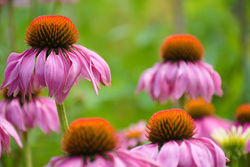Companion planting guide: Maximizing the potential of your vegetable garden
- Lars Wildes
- Feb 6, 2023
- 5 min read
Companion-planting-guideGrowing a vegetable garden can be deliciously wonderful, but it’s not without challenges.
From dealing with pests to improving soil health, many factors can affect the growth and yield of your plants.
One of the keys to success is companion planting, where different plants are grown together to enhance their growth and productivity.
In this article, we'll explore the concept of companion planting and highlight the role perennials and other plants play in creating a diverse and successful vegetable garden.
From improving soil health to repelling pests, finding the right companion plants for your veg garden can help you maximize the potential and create the salad of your dreams.
What is companion planting?
Companion planting is a gardening technique where different plants are grown together for mutual benefits, such as improving growth, deterring pests, or enhancing the soil. Companion planting can be used in both vegetable gardens and ornamental gardens to improve the health and productivity of the plants.
For example, some flowers can be used as companion plants to repel pests and improve the growth of vegetables.
Marigolds, for example, are often planted near tomatoes to deter tomato hornworms, and basil is said to improve the growth and flavor of tomatoes when planted nearby.
In ornamental gardens, companion planting helps to improve the health and beauty of the plants. For example, flowers such as lavender and roses can be planted together to create a fragrant and attractive garden. The lavender provides fragrance and attracts pollinators, while the roses add color and beauty to the garden.
It's important to note that not all plants grow well together (we’ll list those below, too) and it's important to research which plants make good companion plants before planting them together. Always check with your local plant nursery or gardening expert for what works in your area.
Quick companion planting (and what not to plant) guide
Tomatoes

Companion plants: basil, carrots, chives, marigold
Do not plant: corn, dill, fennel, potatoes
Marigolds emit a chemical that repels tomato pests. Basil helps repel flies and mosquitoes and nasturtiums act as a trap crop for aphids. Garlic helps repel aphids and Japanese beetles, and Chives can repel aphids, carrot flies, and other pests.
Brassicas (cabbages and mustards) release a chemical called allelopathic that suppresses the growth of tomatoes. Corn can shade out the tomatoes, while Nightshade family plants can attract pests and diseases that can also harm the tomatoes.
Cucumbers

Companion plants: beans, peas, radishes, sunflowers
Do not plant: aromatics such as dill and fennel
Beans and Peas help fix nitrogen in the soil and sunflowers can provide shade. Radishes help deter pests like the cucumber beetle, and Nasturtiums act as a trap crop for pests.
Aromatic herbs release strong fragrances that can repel cucumber beetles, the main pest of cucumbers. Melons and cucumbers are often affected by the same diseases, and growing them together can increase the risk of disease spread. Potatoes also release allelopathic substances that can stunt the growth of cucumbers.
Peppers

Companion plants: basil, carrots, chives, marigold
Do not plant: fennel, kohlrabi
Basil helps repel flies and mosquitoes, Tomatoes and Carrots help deter the flea beetle, and Eggplants and Onions help repel aphids and spider mites.
Brassicas release allelopathic substances that can stunt the growth of peppers, while fennel produces a chemical that can attract aphids, a common pest of peppers.
Squash

Companion plants: beans, corn, marigold, nasturtiums
Do not plant: potatoes
Corn provides a structure for climbing squashes, and beans help fix nitrogen in the soil. Radishes help deter pests like the squash bug, Nasturtiums can act as a trap crop for pests, and Borage improves soil health and repels pests.
Corn can also shade out the squash, reducing light exposure and hindering growth, so be careful how you plant it and how much you grow near squash. Melons and potatoes can also attract pests and diseases that can harm the squash.
Carrots

Companion plants: chives, lettuce, onions, parsley
Do not plant: dill, or tomatoes
Chives, Onions, and Leeks help deter carrot flies. Peas help fix nitrogen in the soil which can benefit carrots, and Radishes are said to improve the growth and flavor of carrots.
Carrots and dill have similar nutrient requirements, leading to competition for resources in the soil. Parsley and tomatoes secrete chemicals that can inhibit the growth of carrots.
Garlic

Companion plants: apple trees, roses, tomatoes, peppers
Do not plant: peas, or beans
Lettuce

Companion plants: beets, carrots, radishes, strawberries
Do not plant: brassicas such as broccoli and cauliflower
Carrots can improve soil health and deter pests like the cutworm, Radishes can help deter pests like the aphid and flea beetle, Beets can improve soil health, Onions can repel aphids and improve soil health, and Strawberries can improve soil health and add organic matter to the soil.
Brassicas release allelopathic substances that can stunt the growth of lettuce, while cucumbers can shade out the lettuce, reducing light exposure and hindering growth.
Beans

Companion plants: corn, cucumbers, peas, potatoes
Do not plant: onions, or garlic
Corn provides support for climbing beans, Radishes help deter Mexican bean beetles, Carrots can repel bean flies, Cucumbers can help improve soil health and Sunflowers can provide shade for the beans.
The Allium family (onions, garlic, chives, leeks, and shallots) produce a chemical that can stunt the growth of beans and reduce their yield.
Peas

Companion plants: carrots, radishes, turnips, potatoes
Do not plant: onions, or garlic
Beets

Companion plants: lettuce, onions, kohlrabi
Do not plant: pole beans
Radishes

Companion plants: beans, lettuce, melons, cucumbers
Do not plant: brassicas
Spinach

Companion plants: strawberries, brassicas
Do not plant: tomatoes
Cauliflower

Companion plants: dill, nasturtiums, rosemary, sage
Do not plant: tomatoes
Aromatic herbs can help repel pests and improve soil health, Beets can improve soil health, Carrots can help deter pests like the diamondback moth, Dill can help repel pests, and Mint can help improve soil health and deter pests.
Broccoli

Companion plants: dill, rosemary, sage
Do not plant: strawberries
Aromatic herbs can help repel pests and improve soil health, Beets can improve soil health, Carrots can help deter pests like the diamondback moth, Dill can help repel pests, and Mint can help improve soil health and deter pests.
Potatoes

Companion plants: beans, corn, peas
Do not plant: tomatoes, peppers, eggplants, cucumbers, types of squash
Perennials as companion plants
There are perennials that improve the growth and yield of vegetables in a companion planting setup. Here are a few examples… you’ll also find several of them listed above:
Nasturtiums
These brightly colored flowers are known to act as trap crops, drawing pests away from other plants in the garden.
Borage
This plant is known to improve soil health and attract beneficial insects to the garden, making it an ideal companion for a variety of vegetables.
Chives
This herb is known to repel pests like aphids, slugs, and Japanese beetles, making it a great companion for plants that are susceptible to these pests.
Yarrow
This perennial is known to improve soil health, attract beneficial insects to the garden, and also repel pests like slugs and Japanese beetles.
Marigolds
These bright flowers are known to help protect vegetables from nematodes and other soil-borne pests, making them a great companion for root vegetables like carrots and potatoes.






Commentaires